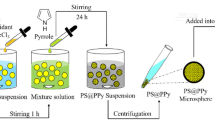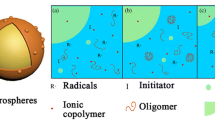Abstract
Polystyrene/polycarbonate (PS/PC) composite hollow microspheres were successfully prepared via microencapsulation method. Fourier-transform infrared spectroscopy, scanning electron microscopy (SEM), differential scanning calorimetry, and thermogravimetric analysis were used for the characterization of the obtained hollow microspheres. SEM images showed that there were a big cavity and some small cavities inside the composite hollow microspheres, and the hollow microspheres prepared at 42 °C presented better morphology and smaller size distribution compared with that prepared at higher temperature of solvent evaporation. The tap density of the composite hollow microspheres increased from 0.28 g cm−3 at PS/PC composite concentration of 5 wt% in oil phase to 0.42 g cm−3 at concentration of 11.7 wt%. The mean diameter of the composite hollow microspheres ranged from 13 to 528 μm. It increased with an increase in the concentration of composite in oil phase and decreased with increasing the second rotating speed. Thermal analysis showed that the composite hollow had thermal stability below 358 °C.










Similar content being viewed by others
References
Ansermet JP, Baeriswyl E (1994) J Mater Sci 29:2841. doi:10.1007/BF01117591
Verweij H, With G, Veeneman D (1985) J Mater Sci 20:1069. doi:10.1007/BF00585751
Joseph NJ, Lakshmi S, Jayakrishnan A (2002) J Control Release 79:71
Xu XL, Sanford AA (2004) J Am Chem Soc 9:7940
Naskar MK, Chatterjee M, Lakshmi NS (2002) J Mater Sci 37:343. doi:10.1023/A:1013656413578
Guan G, Zhang Z, Wang Z, Liu B, Gao D, **e C (2007) Adv mater 19:2370
Li SY, Nguyen Lynsa, **ong HR (2010) Nanomedicine 6:127
Kato T, Ushijima H, Katsumata M, Hyodo T, Shimizu Y (2002) J Mater Sci 37:2317. doi:10.1023/A:1015381603159
Wang XX, Ji HF, Zhang X, Zhang H, Yang XL (2010) J Mater Sci 45:3981. doi:10.1007/s10853-010-4470-z
Tsuji R, Ogushi Y (1997) Fusion Eng Des 34–35:811
Mishra KK, Khardekar RK, Singh R, Pan HC (2002) Pramana-J Phys 59:113
Zhang YP, Chu Y, Dong LH (2007) Nanotechnology 18:435608
He XD, Ge XWW, Wang MZ, Zhang ZC (2005) Polymer 46:7598
Lee WJ, Dong CL (2000) Polymer 41:1749
Sai S, Adam DM, Mary CB (2007) Int J Solids Struct 44:2381
Freitas S, Merkle HP, Gander B (2004) J Control Release 102:313
Yuan L, Gu AJ, Liang GZ (2008) Mater Chem Phys 110:417
Tan WT, Radhi MM, Rahman MZA, Kassim AB (2010) J Appl Sci 10:139
Bok NJ, Charles AW (2005) Thermochim Acta 426:73
Crotts G, Park TG (1995) J Control Release 35:91
Gao F, Su ZG, Wang P, Ma GH (2009) Langmuir 25:3832
Yang YY, Chung TS, Ng NP (2001) Biomaterials 22:231
Iosif DR, Fumio W, Motohiro U (2004) J Control Release 99:271
Yang YY, Chung TS, Bai XL, Chan WK (2000) Chem Eng Sci 55:2223
Yang YY, Chia HH, Chung TS (2000) J Control Release 69:81
Li M, Olivier R, Denis P (2008) Int J Pharm 363:26
Yang YY, Chung TS, Ng NP (2001) Biomaterials 22:231
Bok NJ, Charles AW (2004) Polym Degrad Stabil 86:419
Acknowledgements
The authors gratefully acknowledge China University of Petroleum (Bei**g) for giving them the opportunity to do this research and for their financial support.
Author information
Authors and Affiliations
Corresponding author
Rights and permissions
About this article
Cite this article
Li, J., Wang, S., Liu, H. et al. Preparation and characterization of polystyrene/polycarbonate composite hollow microspheres by microencapsulation method. J Mater Sci 46, 3604–3610 (2011). https://doi.org/10.1007/s10853-011-5276-3
Received:
Accepted:
Published:
Issue Date:
DOI: https://doi.org/10.1007/s10853-011-5276-3




